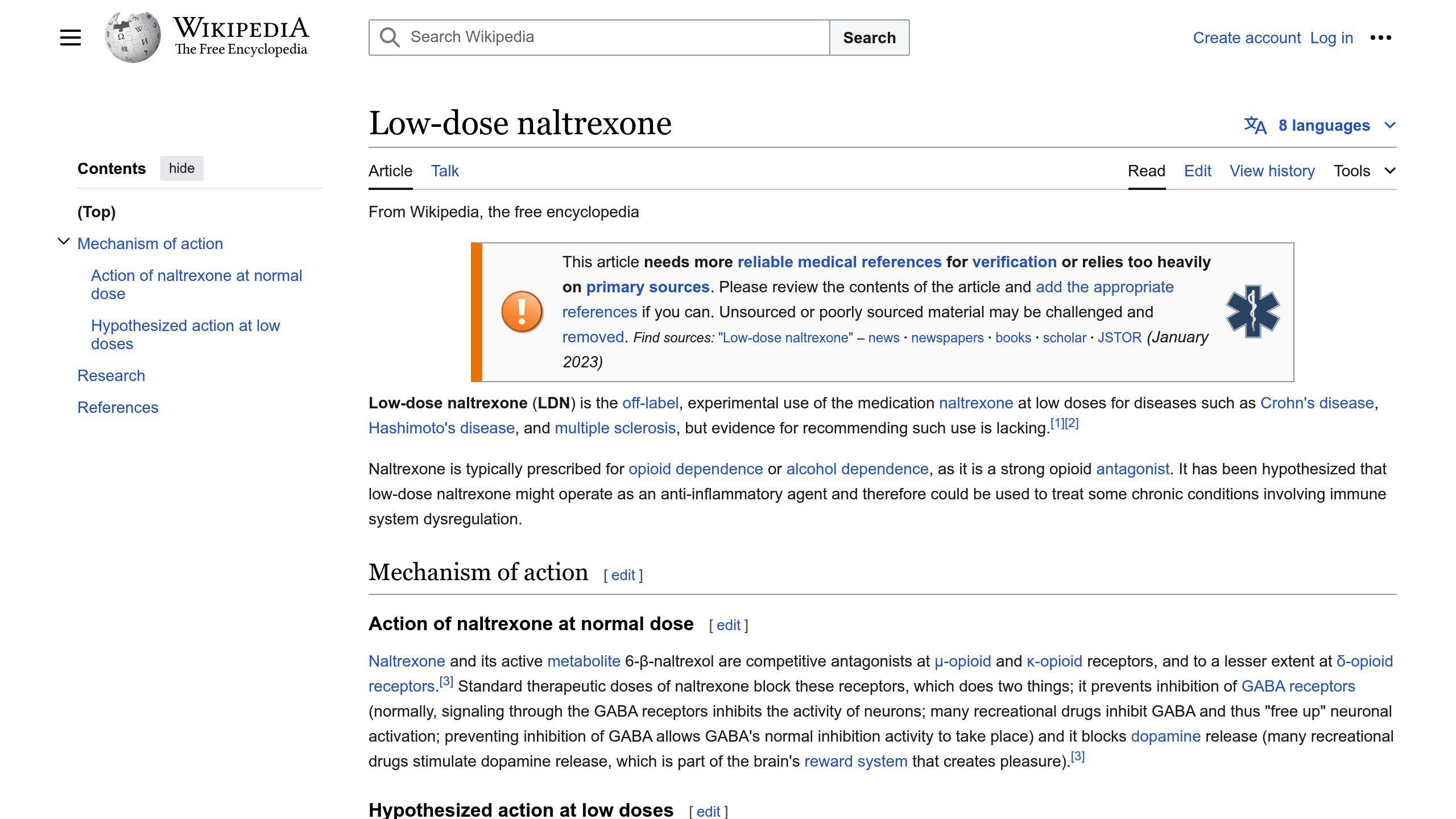Low-dose naltrexone (LDN) is a medication that shows promise as a complementary treatment for chronic pain in Chronic Fatigue Syndrome/Myalgic Encephalomyelitis (CFS/ME). LDN may help regulate the immune system, reduce inflammation, and modulate pain pathways, potentially relieving CFS/ME-related pain.
Related video from YouTube
Key Benefits of LDN for CFS/ME
- Regulates the immune system
- Reduces chronic inflammation
- Alleviates pain
- Improves fatigue
- Addresses cognitive issues
Potential Side Effects
- Nausea or vomiting
- Insomnia or sleep disturbances
- Headaches
- Vivid dreams or nightmares
- Dizziness or lightheadedness
While some patients report improved sleep, reduced pain, and better quality of life with LDN, individual responses vary. Consulting a healthcare provider is crucial to determine if LDN is appropriate and to ensure safe and effective use.
Combining Treatments for Comprehensive Management
Treating CFS/ME requires combining different therapies, such as:
| Treatment | Purpose |
|---|---|
| Cognitive-behavioral therapy (CBT) | Coping strategies, managing symptoms |
| Physical therapy | Increasing activity levels, building strength |
| Nutritional support | Addressing deficiencies, supporting overall health |
| Mindfulness and meditation | Managing emotional and mental aspects |
A tailored treatment plan combining various approaches is often most effective for managing CFS/ME’s complex symptoms, including chronic pain.
While the current evidence is encouraging, larger clinical trials are necessary to establish LDN’s effectiveness and safety for CFS/ME pain management. More research is required to understand optimal dosing, potential side effects, and long-term implications of LDN use in this patient population.
Chronic Pain in CFS/ME
Types of Pain
People with Chronic Fatigue Syndrome/Myalgic Encephalomyelitis (CFS/ME) often experience chronic pain. The most common types include:
-
Muscle and Joint Pain: Widespread muscle aches, joint pain, and body aches are common. This pain can move from one area to another.
-
Nerve Pain: Some feel burning, tingling, or electric shock-like sensations, often in the hands and feet.
-
Headaches: Severe, frequent headaches of a new type, pattern, or intensity are typical.
Impact on Daily Life
Chronic pain in CFS/ME can greatly affect daily life:
| Area | Impact |
|---|---|
| Physical | Pain limits mobility, makes activities difficult, and increases fatigue. |
| Emotional | Persistent pain can lead to anxiety, depression, and distress. |
| Social | Pain makes it hard to participate in social activities, causing isolation. |
Treatment Challenges
Managing chronic pain in CFS/ME can be difficult due to:
1. Limited Relief from Medications
Over-the-counter or prescription pain medications may only provide partial relief or have side effects.
2. Difficulty with Physical Therapy
Physical therapy techniques can be challenging due to increased fatigue and post-exertional malaise.
3. Lifestyle Changes
Modifying activities and managing stress can help, but may not provide complete relief and require significant effort.
4. Lack of Targeted Treatments
There is a need for more effective treatments specifically designed to address the underlying causes of chronic pain in CFS/ME.
sbb-itb-cf04d29
Understanding Low-Dose Naltrexone

What is Naltrexone?
Naltrexone is a medicine first approved by the FDA in 1984. At standard doses, it helps treat opioid addiction by blocking the effects of opioid drugs in the brain and body.
Low Doses for Different Uses
While standard doses block opioid receptors, research shows that very low doses (less than 5 mg) may have other effects:
- Modulate (adjust) the immune system
- Reduce inflammation
This makes low-dose naltrexone (LDN) a potential treatment for chronic pain and autoimmune conditions.
How LDN May Work
The proposed way LDN works:
- LDN temporarily blocks opioid receptors
- This causes the body to produce more natural opioids like endorphins and enkephalins
- These natural opioids then bind to available receptors
- This reduces inflammation and modulates immune function
Potential Benefits and Side Effects
| Potential Benefits | Potential Risks and Side Effects |
|---|---|
| – Reduced inflammation and pain | – Sleep disturbances or vivid dreams (temporary) |
| – Improved immune function | – Nausea or headaches (uncommon) |
| – Relief from autoimmune symptoms | – Interactions with certain medications |
| – Cost-effective treatment option | – Lack of long-term safety data |
| – Few side effects compared to other medications |
LDN is generally well-tolerated, with most side effects being mild and temporary. However, it’s important to talk to your doctor before starting LDN, especially if you have liver or kidney disease or take other medications.
How LDN May Help CFS/ME
Regulating the Immune System
Low-dose naltrexone (LDN) may help regulate the immune system in people with chronic fatigue syndrome/myalgic encephalomyelitis (CFS/ME). This condition involves an abnormal immune response, with evidence suggesting issues with natural killer (NK) cells and other immune cells. LDN may help restore balance to the immune system by modulating the activity of these cells.
Research shows that LDN can influence the function of TRPM3 ion channels, which play a role in regulating NK cell activity and calcium signaling. By modulating TRPM3, LDN may help normalize the immune response in CFS/ME patients, reducing chronic inflammation and fatigue.
Reducing Inflammation
Inflammation is a key factor in CFS/ME, contributing to many symptoms. LDN has anti-inflammatory effects, which may help alleviate chronic inflammation present in CFS/ME.
One proposed mechanism is that LDN temporarily blocks opioid receptors, leading to an increase in the body’s natural opioids, such as endorphins. These endorphins then bind to available receptors, reducing inflammation and modulating immune function.
By reducing inflammation, LDN may help alleviate symptoms such as pain, fatigue, and cognitive issues in CFS/ME patients.
Pain Relief
Chronic pain is a common and debilitating symptom in CFS/ME patients. LDN may help alleviate this pain through its interaction with the body’s opioid system.
LDN temporarily blocks opioid receptors, leading to an increase in endorphin production. Endorphins are the body’s natural painkillers, and their increased levels may help reduce pain perception and sensitivity in CFS/ME patients.
Additionally, by reducing inflammation, LDN may also indirectly alleviate pain associated with chronic inflammation in CFS/ME.
| Potential Benefits of LDN for CFS/ME |
|---|
| Regulates the immune system |
| Reduces chronic inflammation |
| Alleviates pain |
| Improves fatigue |
| Addresses cognitive issues |
Research and Patient Experiences
Clinical Study Findings
Some clinical studies have looked at how low-dose naltrexone (LDN) may help with chronic fatigue syndrome/myalgic encephalomyelitis (CFS/ME). While larger studies are still needed, the current research suggests LDN may provide symptom relief for some patients.
A 2020 case series published in BMJ Case Reports followed three CFS/ME patients taking LDN. Their responses varied from significant improvements in fatigue, pain, and cognitive function, to a reduction in certain symptoms only. Treatment doses ranged from 4 to 12 mg per day. The authors concluded that clinical trials may be warranted to further investigate LDN’s potential use for this condition.
Another study published in Frontiers in Immunology in 2021 found that CFS/ME patients taking LDN had restored TRPM3-like ionic currents in their natural killer (NK) cells, supporting the idea that LDN may help regulate immune function by modulating TRPM3 ion channels.
Case Study Examples
The BMJ Case Reports series included detailed case studies showing varied patient experiences with LDN:
1. Case 1: A physician who developed severe CFS/ME after viral meningitis reported a "life-changing" response to LDN, with significant improvements in fatigue, cognitive function, and pain levels after years of being bedridden.
2. Case 2: A 29-year-old woman with CFS/ME experienced better sleep quality and reduced pain after starting LDN treatment.
3. Case 3: A male patient with longstanding CFS/ME reported improvements in sleep, mood, and overall quality of life while taking LDN.
Patient Testimonials
Many CFS/ME patients have shared their experiences with LDN on online forums and support groups. While anecdotal, these testimonials provide real-world insights into LDN’s potential benefits and limitations.
| Positive Experiences | Negative Experiences |
|---|---|
| Reduced fatigue and brain fog | No significant improvement |
| Improved sleep quality | Mild side effects (nausea, insomnia) |
| Decreased pain and muscle aches | Inconsistent or fluctuating results |
| Increased energy and stamina | Benefits wore off over time |
Research Limitations
While promising, the current research on LDN for CFS/ME is limited by small sample sizes, lack of control groups, and potential biases. Larger, well-designed clinical trials are needed to establish LDN’s efficacy, optimal dosing, and long-term safety for this condition.
Additionally, CFS/ME is a complex and heterogeneous illness, and individual responses to LDN may vary. More research is needed to understand which subgroups of patients may benefit most from this treatment approach.
Using LDN for CFS/ME
Starting LDN Treatment
For CFS/ME patients, LDN treatment usually starts with a low dose, like 0.5 mg or 1.5 mg per day. The dose is then slowly increased every 1-2 weeks until the right dose is reached, often around 4.5 mg per day. However, some patients may need higher doses up to 12 mg per day, as seen in case reports.
Work closely with your healthcare provider to find the right starting dose and schedule for increasing the dose. They will consider factors like your symptom severity, response to treatment, and any side effects.
Monitoring and Adjustments
Regular follow-up appointments with your healthcare provider are important for checking how well LDN is working and if you’re tolerating it well. Your dose may need to be adjusted based on your response and any side effects.
Your provider will monitor your symptoms, pain levels, sleep quality, cognitive function, and overall quality of life during treatment. They may use symptom scales or assessments to track your progress and guide dose changes.
Possible Side Effects
LDN is generally well-tolerated, but some patients may experience mild side effects when starting or increasing the dose. Common side effects reported include:
- Nausea or vomiting
- Insomnia or sleep disturbances
- Headaches
- Vivid dreams or nightmares
- Dizziness or lightheadedness
These side effects are usually temporary and may go away with continued treatment or dose adjustments. If side effects persist or become severe, your healthcare provider may lower the dose or stop LDN.
Safety Precautions
LDN is generally considered safe when prescribed and monitored by a qualified healthcare provider. However, there are some precautions to consider:
| Precaution | Explanation |
|---|---|
| Pregnancy and breastfeeding | The safety of LDN during pregnancy and breastfeeding is not established. Discuss the potential risks and benefits with your provider. |
| Liver or kidney disease | Patients with impaired liver or kidney function may need dose adjustments or close monitoring, as naltrexone is metabolized by the liver and excreted by the kidneys. |
| Opioid use | LDN should not be taken by individuals currently using opioid medications or undergoing opioid-assisted therapy, as it can cause withdrawal symptoms. |
| Drug interactions | Inform your healthcare provider about all medications, supplements, and herbal products you are taking to check for potential interactions with LDN. |
It’s crucial for CFS/ME patients to consult with a healthcare provider knowledgeable about LDN and follow their guidance regarding dosing, monitoring, and safety precautions to ensure the safe and effective use of this treatment.
Managing CFS/ME: A Comprehensive Approach
Combining Treatments
Treating Chronic Fatigue Syndrome/Myalgic Encephalomyelitis (CFS/ME) requires combining different therapies. While low-dose naltrexone (LDN) may help, it works best when used with other treatments for managing symptoms.
Complementary Therapies
Cognitive-behavioral therapy (CBT) can help CFS/ME patients cope with the condition’s psychological impact, improve coping strategies, and manage symptoms like fatigue and pain. Physical therapy aids in gradually increasing activity levels, building muscle strength, and reducing pain through gentle exercises and massage.
Nutritional support, including dietary changes and supplements, may address deficiencies and support overall health. Mindfulness, meditation, and stress management techniques can help manage the emotional and mental aspects of CFS/ME.
Comparing Pain Management Options
Various treatments exist for managing chronic pain in CFS/ME, each with pros and cons:
| Treatment | Advantages | Disadvantages |
|---|---|---|
| LDN | May relieve pain, regulate immune system | Requires medical supervision, possible side effects |
| Medication | Immediate pain relief, various options | Side effects, risk of dependency |
| CBT | Addresses psychological aspects, no medication | Requires commitment, may not address all physical symptoms |
| Physical Therapy | Improves function, long-term pain reduction | Requires regular sessions, can be physically demanding |
While LDN offers potential pain relief and immune regulation, it needs medical oversight and may cause side effects. Medications provide immediate relief but carry risks. CBT addresses psychological aspects without medication but may not fully alleviate physical symptoms. Physical therapy can effectively manage pain long-term but requires consistent effort and can be physically demanding for some CFS/ME patients.
A tailored treatment plan combining various approaches is often most effective for managing CFS/ME’s complex symptoms, including chronic pain.
Conclusion
Key Points
- Low-dose naltrexone (LDN) shows promise as a complementary treatment for chronic pain in Chronic Fatigue Syndrome/Myalgic Encephalomyelitis (CFS/ME).
- LDN may help regulate the immune system, reduce inflammation, and modulate pain pathways, potentially relieving CFS/ME-related pain.
- Some patients report improved sleep, reduced pain, and better quality of life with LDN.
- However, individual responses vary, and consulting a healthcare provider is crucial to determine if LDN is appropriate.
More Research Needed
- While the current evidence is encouraging, larger clinical trials are necessary to establish LDN’s effectiveness and safety for CFS/ME pain management.
- Further research is required to understand optimal dosing, potential side effects, and long-term implications of LDN use in this patient population.
- Additional studies can provide insights into the mechanisms by which LDN may alleviate CFS/ME symptoms and improve overall well-being.
Consult Healthcare Providers
- Before considering LDN, consult a qualified healthcare provider experienced in managing CFS/ME and chronic pain conditions.
- Healthcare providers can evaluate individual circumstances, discuss potential risks and benefits, and provide guidance on appropriate dosing and monitoring.
- It is essential to follow medical advice and not self-medicate with LDN or any other treatment without proper medical supervision.
Related posts
- Stimulants for CFS/ME: Uses, Benefits, Risks
- Antioxidants for CFS/ME: Benefits, Diet Tips
- Homeopathic Remedies for CFS/ME: Treatment Guide
- Acupuncture for Chronic Fatigue Syndrome: Research Overview






Leave a Reply